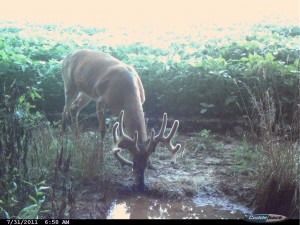I’ll never forget the first time I bowhunted whitetails over a manmade water source. It was in the mid-1990s, and I was deer hunting the famed bluffs of Buffalo County, Wisconsin. This was my first trip to this land of Boone and Crockett-class bucks, and I was hunting with legendary outfitter Tom Indrebo.

As, daylight filtered through the woods on the first morning of my hunt, I noticed a “pond” appear before my eyes. Tom had told me about the water source, and had indicated it was a magnet for attracting big bucks during unseasonably warm autumn days. He wasn’t kidding. In the first three hours of that hunt, I watched as more than 10 bucks appeared, cautiously approached the water source, and drank. Two of the deer were dandies but they never came close enough for a shot.
What surprised me most about this “pond,” was it really wasn’t what I was expecting. It really wasn’t a pond in my definition. To me, it seemed like it was nothing more than a trench dug into the hilltop by a bulldozer blade. I later learned that it was indeed just that. Earlier that year, Tom had used his heavy machinery to trench several similar spots on his property.
SEE ALSO: Daily updates on deer and super photography!
The soil, heavy clay, was thick enough to hold rainwater. He said he had dabbled with the practice for several years and learned that it was just the ticket for creating additional water sources for deer — and killer hunting spots. His innovative idea paid off in altering deer behavior. Although I didn’t kill a buck that trip, many of Tom’s hunters — dozens, in fact — have hunted these spots over the years with tremendous success.
How much water do deer need? That’s an age-old question among deer hunters. According to Deer & Deer Hunting Contributing Editor Dr. Phillip Bishop, deer lose water in three primary, and two minor ways. They lose water in their urine, in their droppings, and also as they breathe.
“Unlike humans, deer pant to lose heat and sweat only a little to cool themselves,” Bishop states. “Not sweating works to conserve some water. Panting causes some water loss, but not nearly so much as sweating. Deer also lose a small amount of water through their skin, but this is negligible compared to the other water losses.”
Opinions vary, but most experts suggest that whitetails need about 2 to 3 quarts of water per day per 100 pounds of body weight. Apparently, the water needs increase in hot and dry weather, probably because of panting, and small increases in skin water loss.
“First, we start with the 2- to 3-quart needs of a deer per 100 pounds,” Bishop continues. “For a 150-pound deer, this would mean 3 to 4.5 quarts of water per day. Next, we need to know the approximate water contents of typical deer food. Acorns are about 70 percent water. In Alabama, smilax (green briar or cat briar) shoots are also very high in moisture, not to mention a very popular deer food in spring, summer and early fall. You’ll seldom find a patch of cat briar without most of the ends nipped off by browsing deer. In fact, I enjoy eating it myself. It tastes like green beans, only better.”
Cat briar is comparable to lettuce. Although probably a bit moister than most whitetail foods, lettuce is 96 percent water. Apples are about 80 percent water. Woody browse should be similar to acorns and persimmons similar to apples. Some leafy succulent vegetation would be more like lettuce.
In spring, foods with higher water would be more widely available but during hunting season, the foods with lower water content would compose more of the typical deer diet. With this in mind, Bishop arbitrarily picked 80 percent as the average water content for a mixed deer diet.
SEE ALSO: Amazing footage about whitetail behavior you haven’t seen before!
One quart of water weighs just over 2 pounds. If a 150-pound deer ate 8 pounds of food per day, at 80 percent water, then that deer consumed about 6.4 pounds of water. This weight of water converts to about 3 quarts of water. Recall the earlier estimate that a 150-pound deer would need 3 to 4.5 quarts per day.
So the answer to the question, do deer need to drink, is … it depends. If deer are eating a lot of lower-moisture foods such as acorns, and they are panting a lot (and sweating a little) due to high temperatures, then they may need to drink a little water.
You might be thinking this is impractical because temperatures are rarely high during hunting season. Not true. In Southern states, particularly during archery season, it is not uncommon for temperatures to reach high 80s. If deer are eating more moist foods and the weather is cooler, then they might not need to drink water.
Bishop’s conclusion?
“Deer do drink when water is available, but they can get by quite well with minimal drinking … most of the time. It is likely that there is variability among deer in how much water they need and their preference for drinking.”
____________________________________








